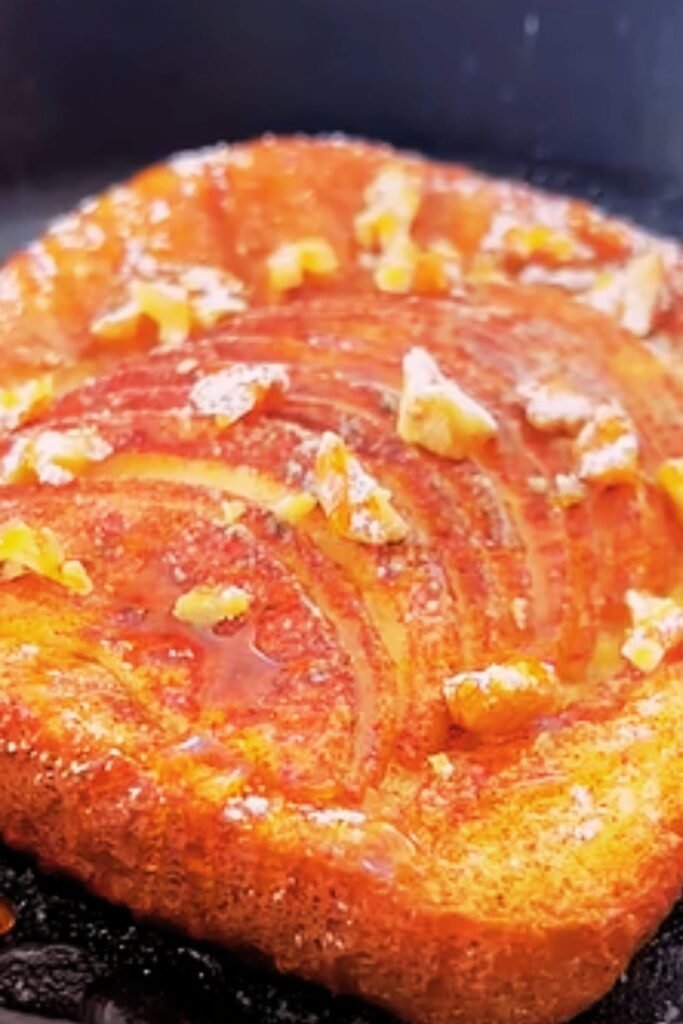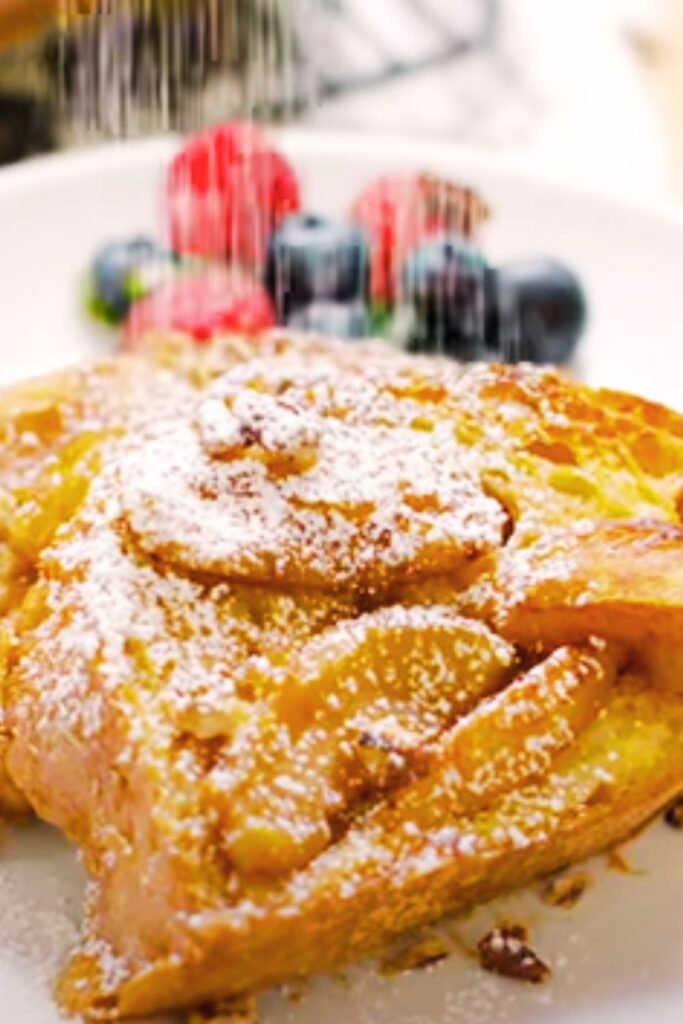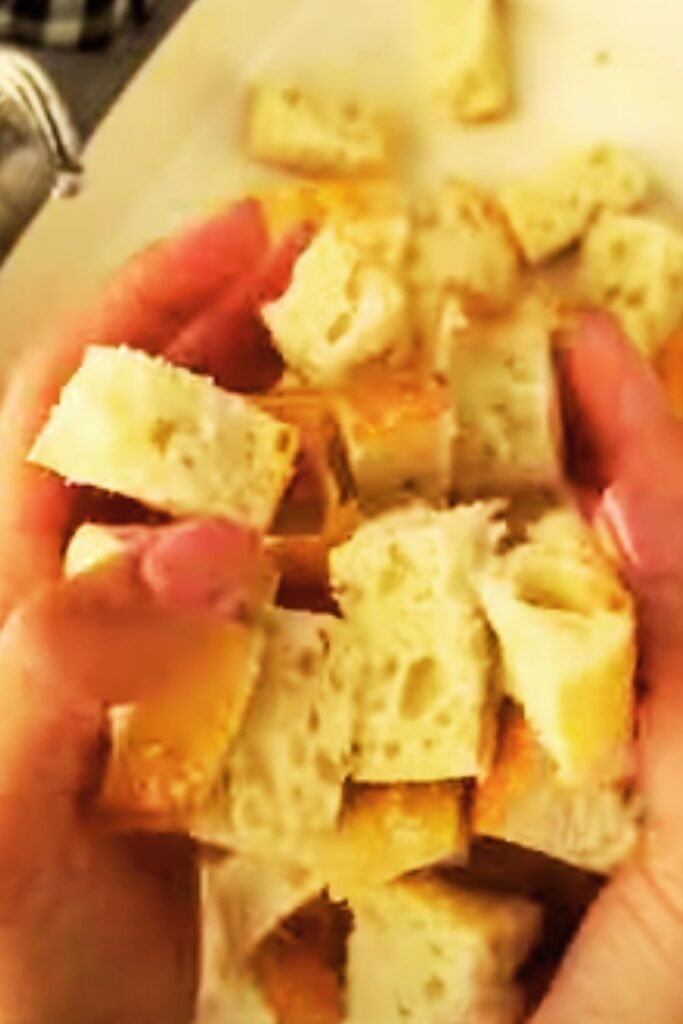There’s something magical about waking up to the aroma of cinnamon and vanilla wafting through my kitchen. Apple Cinnamon French Toast has become my go-to weekend breakfast, transforming ordinary bread into something extraordinary. This recipe combines the classic comfort of French toast with the warm, spiced flavors of apple pie, creating a breakfast that feels like a special occasion every time.
I’ve spent years perfecting this recipe, experimenting with different bread types, custard ratios, and apple preparations. What I’m sharing with you today is the culmination of countless Sunday mornings, family gatherings, and the joy of watching loved ones savor every bite. This isn’t just French toast – it’s a celebration of flavors that brings people together around the breakfast table.
What Makes This Apple Cinnamon French Toast Special
Unlike traditional French toast that relies solely on the custard mixture for flavor, my version incorporates tender, spiced apples both within the bread and as a luxurious topping. The apples are sautéed with cinnamon, brown sugar, and a touch of vanilla, creating a caramelized mixture that elevates every bite.
The secret lies in the custard base, which I’ve enriched with heavy cream, vanilla extract, and a pinch of nutmeg. This creates French toast that’s crispy on the outside yet incredibly custardy on the inside. The bread soaks up just enough of the mixture to transform completely while maintaining its structure.
Essential Ingredients Breakdown
For the Apple Topping:
- Fresh apples: I prefer Honeycrisp or Granny Smith for their balance of sweetness and tartness
- Brown sugar: Creates beautiful caramelization and adds molasses notes
- Ground cinnamon: The star spice that ties everything together
- Butter: For sautéing and richness
- Vanilla extract: Enhances the overall flavor profile
- Lemon juice: Prevents browning and adds brightness
For the French Toast:
- Thick-cut bread: Challah, brioche, or Texas toast work best
- Large eggs: The foundation of our custard base
- Heavy cream: Creates the richest, most luxurious texture
- Whole milk: Balances the richness of the cream
- Vanilla extract: Essential for authentic French toast flavor
- Ground cinnamon: Complements the apple topping
- Nutmeg: A subtle warming spice that makes a difference
- Salt: Enhances all the other flavors

Detailed Nutritional Information
| Nutrient | Per Serving (2 slices) | Daily Value % |
|---|---|---|
| Calories | 485 | 24% |
| Total Fat | 18g | 23% |
| Saturated Fat | 10g | 50% |
| Cholesterol | 195mg | 65% |
| Sodium | 420mg | 18% |
| Total Carbohydrates | 68g | 25% |
| Dietary Fiber | 4g | 14% |
| Sugars | 32g | – |
| Protein | 14g | 28% |
| Vitamin C | 8mg | 9% |
| Calcium | 180mg | 14% |
| Iron | 3mg | 17% |
Step-by-Step Preparation Guide
Preparing the Apple Topping
I always start with the apple topping because it can simmer while I prepare the French toast, and the flavors have time to meld beautifully.
- Apple Selection and Preparation: Choose firm apples that won’t turn to mush when cooked. I peel and core 3 medium apples, then slice them into thin, uniform pieces. This ensures even cooking and an attractive presentation.
- Creating the Caramelized Base: In a large skillet over medium heat, I melt 3 tablespoons of butter. The butter should foam and smell nutty but not brown. Add 1/3 cup of packed brown sugar, stirring constantly until it begins to dissolve and bubble.
- Adding the Apples: Carefully add the sliced apples to the skillet. They’ll sizzle and steam initially. Sprinkle with 1 teaspoon of ground cinnamon and a pinch of salt. Cook for 8-10 minutes, stirring occasionally, until the apples are tender but still hold their shape.
- Final Touches: Remove from heat and stir in 1 teaspoon of vanilla extract and 1 tablespoon of fresh lemon juice. The mixture should be glossy and fragrant. Set aside and keep warm.
Crafting the Perfect Custard Base
The custard is where French toast magic happens. I’ve tested countless ratios to achieve the perfect balance of richness and absorption.
- Combining the Wet Ingredients: In a large, shallow dish, I whisk together 6 large eggs until completely smooth. Add 1/2 cup of heavy cream, 1/2 cup of whole milk, and 2 teaspoons of vanilla extract. The mixture should be well combined and slightly frothy.
- Seasoning the Custard: Whisk in 1 teaspoon of ground cinnamon, 1/4 teaspoon of nutmeg, and 1/2 teaspoon of salt. These spices will infuse every bite with warmth and complexity.
- Achieving the Right Consistency: The finished custard should coat the back of a spoon lightly. If it seems too thick, add a splash more milk. Too thin, and another egg will help bind everything together.

Bread Selection and Soaking Technique
Choosing the Right Bread: I’ve experimented with various breads, and thick-cut challah remains my favorite. Its rich, eggy flavor complements the custard beautifully, and its structure holds up to soaking without falling apart. Brioche is my second choice, followed by thick Texas toast.
The Soaking Process: This is where patience pays off. I place each slice of bread in the custard mixture, allowing it to soak for 2-3 minutes per side. The bread should feel heavy and saturated but not falling apart. Press gently with a spatula to ensure even absorption.
Cooking to Perfection
Pan Preparation: I use a large, heavy-bottomed skillet or griddle heated to medium heat. A drop of water should sizzle and evaporate quickly. I add 1 tablespoon of butter, letting it melt and coat the surface evenly.
Cooking Technique: Place the soaked bread slices in the pan, being careful not to overcrowd. Cook for 3-4 minutes on the first side until golden brown and crispy. The edges should look set and slightly puffed. Flip carefully and cook for another 2-3 minutes until the second side is equally golden.
Temperature Control: Maintaining medium heat is crucial. Too hot, and the outside burns while the inside remains raw. Too cool, and you’ll end up with soggy, pale French toast.
Bread Comparison Chart
| Bread Type | Absorption Rate | Flavor Profile | Best For |
|---|---|---|---|
| Challah | Excellent | Rich, slightly sweet | Traditional French toast |
| Brioche | Very Good | Buttery, tender | Luxurious occasions |
| Texas Toast | Good | Mild, sturdy | Feeding a crowd |
| Sourdough | Fair | Tangy, chewy | Unique flavor twist |
| Whole Wheat | Fair | Nutty, dense | Healthier option |
Cooking Time and Temperature Guide
| Cooking Stage | Temperature | Time | Visual Cues |
|---|---|---|---|
| Apple Preparation | Medium (350°F) | 8-10 minutes | Tender, caramelized |
| Bread Soaking | Room temp | 2-3 minutes per side | Saturated, heavy |
| First Side | Medium (325°F) | 3-4 minutes | Golden brown, set edges |
| Second Side | Medium (325°F) | 2-3 minutes | Matching golden color |
| Resting | Warm oven (200°F) | 2-5 minutes | Maintains temperature |
Serving Suggestions and Presentation
I believe presentation is just as important as taste. Here’s how I serve my Apple Cinnamon French Toast to create a memorable breakfast experience:
Plating Technique: I arrange 2-3 slices of French toast on warmed plates, slightly overlapping for visual appeal. The warm apple mixture gets spooned generously over the top, allowing some to cascade down the sides.
Garnish Options: A light dusting of powdered sugar through a fine-mesh sieve creates an elegant finish. Fresh berries add color and a bright contrast to the rich flavors. A sprig of fresh mint provides a pop of green and aromatic freshness.
Accompaniment Suggestions:
- Real maple syrup warmed slightly in the microwave
- Freshly whipped cream with a touch of vanilla
- Greek yogurt mixed with honey for a healthier option
- Crispy bacon or turkey sausage for protein
- Fresh fruit salad for balance

Storage and Reheating Instructions
Refrigerator Storage: Leftover French toast keeps well in the refrigerator for up to 3 days. I store the bread and apple topping separately in airtight containers to prevent sogginess.
Freezing Guidelines: French toast freezes beautifully for up to 2 months. I place cooled slices on a baking sheet, freeze until solid, then transfer to freezer bags with parchment paper between slices.
Reheating Methods:
- Oven: 350°F for 8-10 minutes until heated through and crispy
- Toaster: Perfect for individual slices, toast on medium setting
- Skillet: A quick reheat in a buttered pan restores the crispy exterior
- Microwave: 30-45 seconds, though this sacrifices crispiness
Variations and Customizations
Over the years, I’ve developed several variations that keep this recipe exciting:
Stuffed Apple Cinnamon French Toast: I create a pocket in thick bread slices and stuff them with cream cheese mixed with diced apples and cinnamon before dipping in custard.
Baked Version: For feeding a crowd, I arrange the soaked bread in a buttered baking dish, top with the apple mixture, and bake at 375°F for 25-30 minutes.
Healthier Options: I substitute whole grain bread, use half-and-half instead of cream, and reduce the sugar in the apple topping by half, adding extra cinnamon for flavor.
Seasonal Twists: In fall, I add a pinch of allspice and cloves to the apple mixture. Winter calls for a touch of orange zest, while spring invites fresh strawberries alongside the apples.
Troubleshooting Common Issues
Problem: French toast is soggy in the middle Solution: Use thicker bread slices and don’t over-soak. Cook on medium heat to ensure the interior sets properly.
Problem: Custard doesn’t stick to the bread Solution: Your custard might be too thin. Add another egg or reduce the liquid slightly.
Problem: Apples turn to mush Solution: Choose firmer apple varieties and don’t overcook. They should be tender but still hold their shape.
Problem: French toast burns before cooking through Solution: Reduce heat to medium-low and cook more patiently. A properly heated pan at the right temperature is key.
Expert Tips for Perfect Results
After making this recipe countless times, here are my insider secrets:
- Day-old bread works best because it absorbs the custard without falling apart
- Room temperature ingredients blend more easily and create a smoother custard
- Don’t rush the apple cooking – proper caramelization takes time and creates depth of flavor
- Keep finished French toast warm in a 200°F oven while cooking remaining batches
- Taste and adjust the apple mixture – some apples are sweeter than others
The Science Behind Perfect French Toast
Understanding what happens during cooking helps achieve consistent results. When bread soaks in the custard mixture, proteins in the eggs begin to denature. During cooking, these proteins coagulate, creating the creamy interior texture we love. The Maillard reaction between proteins and sugars creates the golden-brown exterior and complex flavors.
The starch in bread gelatinizes when heated, helping to thicken the custard and create structure. This is why day-old bread works so well – it has less moisture, allowing for better custard absorption without becoming soggy.
Frequently Asked Questions
Q. Can I make the custard mixture ahead of time? Absolutely! I often prepare the custard the night before and store it covered in the refrigerator. Just give it a good whisk before using, as the ingredients may separate slightly.
Q. What’s the best way to keep French toast warm for a crowd? I preheat my oven to 200°F and place finished French toast on a wire rack set over a baking sheet. This keeps them warm and crispy while I finish cooking the remaining batches.
Q. Can I use frozen bread for this recipe? Yes, but thaw it completely first and let it sit out for a few hours to dry slightly. Frozen bread tends to be more moist, which can lead to soggy French toast.
Q. How do I prevent the apples from browning while I prep other ingredients? Toss sliced apples with a little lemon juice immediately after cutting. This prevents oxidation and browning while adding a bright flavor note.
Q. Is there a dairy-free version of this recipe? I’ve successfully made this using coconut milk and coconut cream in place of dairy. The flavor is slightly different but equally delicious. Use dairy-free butter for cooking as well.
Q. Can I reduce the sugar in this recipe? Absolutely! The brown sugar in the apple mixture can be reduced by half, and you can omit sugar from the custard entirely. The natural sweetness of the apples and a drizzle of maple syrup provide plenty of sweetness.
Q. What’s the ideal thickness for the bread slices? I aim for 3/4 to 1-inch thick slices. Thinner slices become soggy, while thicker ones may not cook through evenly. If your bread is pre-sliced and too thin, you can still make delicious French toast – just reduce the soaking time.
Q. How can I tell when the French toast is properly cooked? The exterior should be golden brown and slightly crispy, while the interior should be set but still creamy. If you’re unsure, insert a knife into the center – it should come out clean with no wet custard.
This Apple Cinnamon French Toast recipe has brought joy to my breakfast table for years, and I’m confident it will do the same for yours. The combination of perfectly custardy French toast with warm, spiced apples creates a breakfast experience that turns ordinary mornings into something special. Take your time with each step, enjoy the process, and most importantly, savor every bite with the people you love.